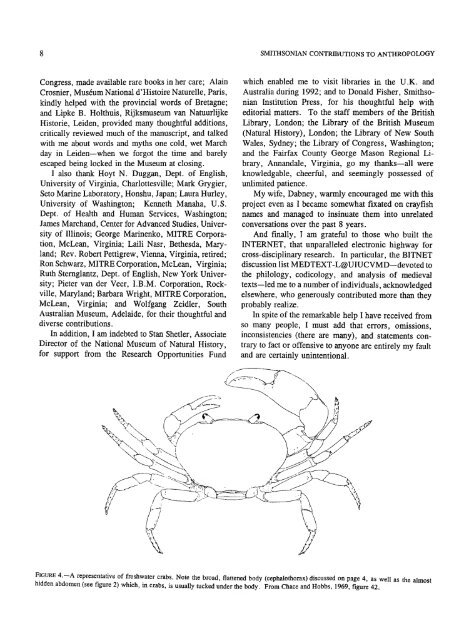A Dictionary of Non-Scientific Names of Freshwater Crayfishes ...
A Dictionary of Non-Scientific Names of Freshwater Crayfishes ...
A Dictionary of Non-Scientific Names of Freshwater Crayfishes ...
You also want an ePaper? Increase the reach of your titles
YUMPU automatically turns print PDFs into web optimized ePapers that Google loves.
Congress, made available rare books in her care; Alain<br />
Crosnier, Museum National d'Histoire Naturelle, Paris,<br />
kindly helped with the provincial words <strong>of</strong> Bretagne;<br />
and Lipke B. Holthuis, Rijksmuseum van Natuurlijke<br />
Historie, Leiden, provided many thoughtful additions,<br />
critically reviewed much <strong>of</strong> the manuscript, and talked<br />
with me about words and myths one cold, wet March<br />
day in Leiden—when we forgot the time and barely<br />
escaped being locked in the Museum at closing.<br />
I also thank Hoyt N. Duggan, Dept. <strong>of</strong> English,<br />
University <strong>of</strong> Virginia, Charlottesville; Mark Grygier,<br />
Seto Marine Laboratory, Honshu, Japan; Laura Hurley,<br />
University <strong>of</strong> Washington; Kenneth Manaha, U.S.<br />
Dept. <strong>of</strong> Health and Human Services, Washington;<br />
James Marchand, Center for Advanced Studies, University<br />
<strong>of</strong> Illinois; George Marinenko, MITRE Corporation,<br />
McLean, Virginia; Laili Nasr, Bethesda, Maryland;<br />
Rev. Robert Pettigrew, Vienna, Virginia, retired;<br />
RonSchwarz, MITRE Corporation, McLean, Virginia;<br />
Ruth Sternglantz, Dept. <strong>of</strong> English, New York University;<br />
Pieter van der Veer, I.B.M. Corporation, Rockville,<br />
Maryland; Barbara Wright, MITRE Corporation,<br />
McLean, Virginia; and Wolfgang Zeidler, South<br />
Australian Museum, Adelaide, for their thoughtful and<br />
diverse contributions.<br />
In addition, I am indebted to Stan Shetler, Associate<br />
Director <strong>of</strong> the National Museum <strong>of</strong> Natural History,<br />
for support from the Research Opportunities Fund<br />
SMITHSONIAN CONTRIBUTIONS TO ANTHROPOLOGY<br />
which enabled me to visit libraries in the U.K. and<br />
Australia during 1992; and to Donald Fisher, Smithsonian<br />
Institution Press, for his thoughtful help with<br />
editorial matters. To the staff members <strong>of</strong> the British<br />
Library, London; the Library <strong>of</strong> the British Museum<br />
(Natural History), London; the Library <strong>of</strong> New South<br />
Wales, Sydney; the Library <strong>of</strong> Congress, Washington;<br />
and the Fairfax County George Mason Regional Library,<br />
Annandale, Virginia, go my thanks—all were<br />
knowledgable, cheerful, and seemingly possessed <strong>of</strong><br />
unlimited patience.<br />
My wife, Dabney, warmly encouraged me with this<br />
project even as I became somewhat fixated on crayfish<br />
names and managed to insinuate them into unrelated<br />
conversations over the past 8 years.<br />
And finally, I am grateful to those who built the<br />
INTERNET, that unparalleled electronic highway for<br />
cross-disciplinary research. In particular, the BITNET<br />
discussion list MEDTEXT-L@UIUCVMD—devoted to<br />
the philology, codicology, and analysis <strong>of</strong> medieval<br />
texts—led me to a number <strong>of</strong> individuals, acknowledged<br />
elsewhere, who generously contributed more than they<br />
probably realize.<br />
In spite <strong>of</strong> the remarkable help I have received from<br />
so many people, I must add that errors, omissions,<br />
inconsistencies (there are many), and statements contrary<br />
to fact or <strong>of</strong>fensive to anyone are entirely my fault<br />
and are certainly unintentional.<br />
FIGURE 4.-A representative <strong>of</strong> freshwater crabs. Note the broad, flattened body (cephalothorax) discussed on page 4, as well as the almost<br />
hidden abdomen (see figure 2) which, in crabs, is usually tucked under the body. From Chace and Hobbs, 1969, figure 42.
















